
HartRAO Home >
news >
Science and Technology Minister visits HartRAO - 2006/08/15
Science and Technology Minister visits HartRAO - 2006/08/15
Minister of Science and Technology Mosibudi Mangena visited the
Hartebeesthoek Radio Astronomy Observatory (HartRAO) on 2006 August 15.
Astronomer Dr. Michael Gaylard acted as the guide for the tour around the
facility, during which the Minister met many of the staff and students and
learned about their work.
Staff astronomer Marion West acted as photographer for the visit, together
with Linda Pretorius from Southern Science. The photo-essay below
illustrates the tour.
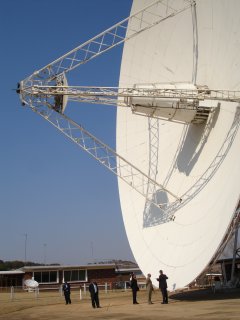
Click on image for LARGE version. Credit: Marion West / HartRAO
First stop was the 26-m radio telescope, where the Minister was able to
take a close look at the 252 new high-accuracy surface panels that have
greatly improved telescope performance.
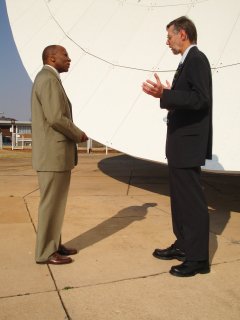
Click on image for LARGE version. Credit: Marion West / HartRAO
Mike Gaylard describes the upgrades to the antenna since it was built in
1961 for a NASA Deep Space tracking station.
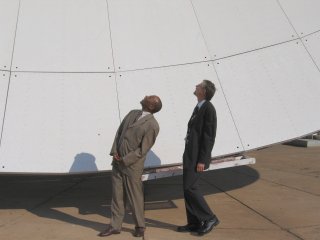
Click on image for LARGE version. Credit: Linda Pretorius /
Southern Science
The Minister inspects the antenna towering over him.
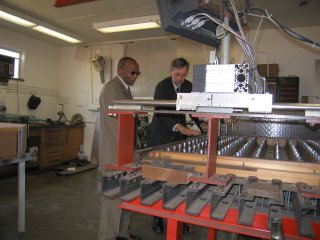
Click on image for LARGE version. Credit: Linda Pretorius /
Southern Science
Next stop was the Surface Upgrade Workshop, where the new antenna surface
panels had been made, on the large "bed of bolts" seen here.
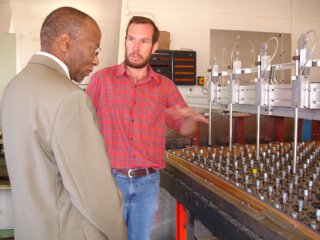
Click on image for LARGE version. Credit: Marion West / HartRAO
Antenna technician Pieter Stronkhorst explains how the panels were measured
to check their accuracy after fabrication.
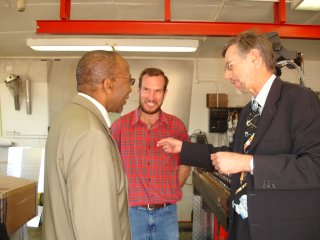
Click on image for LARGE version. Credit: Marion West / HartRAO
Mike reminds the Minister that it was Pieter Stronkhorst and Jacques Grobler
who came to the rescue of an RFI measuring system used for SKA site testing
and rebuilt it after it sustained damage on dirt roads in the Karoo.
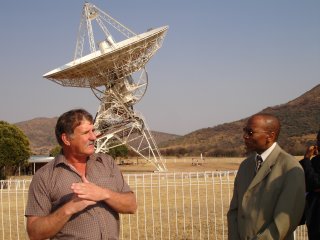
Click on image for LARGE version. Credit: Marion West / HartRAO
Satellite Laser Ranger Manager Johan Bernhardt describes what the SLR is
used for, while the 26-m telescope in the background goes back to monitoring
the recovery of the Vela pulsar after its large glitch (sudden jump in
rotation rate) two days earlier.
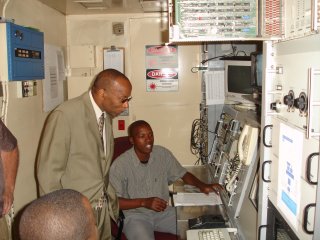
Click on image for LARGE version. Credit: Marion West / HartRAO
SLR operator Sam Tshefu was tracking the Japanese satellite Ajisai as the
Minister entered the SLR control van.
Ajisai is Japanese for Hydrangea. Satellite laser ranging to Ajisai
provides high precision orbit determination and is used to improve the map
of the Earth's gravity field. Launched in 1986, it is a 2.15 metre sphere
covered with 1436 corner cube reflectors and 318 plane mirrors. It orbits
at an altitude of 1490 km.
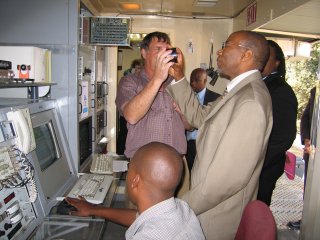
Click on image for LARGE version. Credit: Linda Pretorius /
Southern Science
The Minister was intrigued by the corner reflector, a duplicate of those
mounted on the satellites tracked by the SLR.
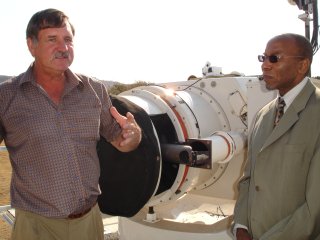
Click on image for LARGE version. Credit: Marion West / HartRAO
In post-track calibration of the SLR on a ground target the SLR operates in
eye-safe low-power mode and the Minister was able to get a close up view of
the laser transmitter and large telescope that receives the returning
photons.
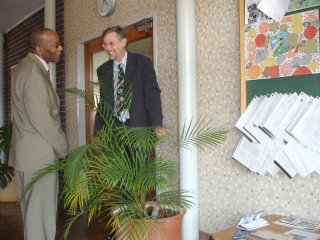
Click on image for LARGE version. Credit: Marion West / HartRAO
The Minister is intrigued by the colourful poster created by a group of
learners from Woodland Primary School who had made an overnight visit at the
Observatory.
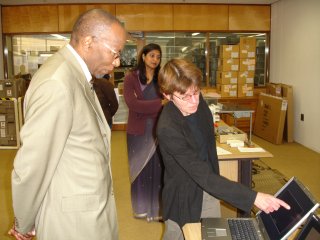
Click on image for LARGE version. Credit: Marion West / HartRAO
A surprise visitor was Dr. Claire Flanagan, Director of the Johannesburg
Planetarium. Claire established the pulsar research programme at HartRAO
and continues to play an active part in it. The Vela pulsar is one that is
closely monitored by the 26-m radio telescope. It typically glitches every
few years, and one of the these events fortuitously occurred two days before
the Ministers visit. In the absence overseas of pulsar observer Sarah
Buchner, Claire stepped in and verified that the glitch detected by the
automated software was real, and reduced the data to establish the glitch
initial parameters. The telescope is currently monitoring the pulsar's
recovery for twelve hours each day while the pulsar is above the horizon.
Here Claire shows the Minister how the pulsar the latest data on the glitch.
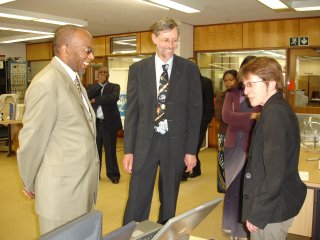
Click on image for LARGE version. Credit: Marion West / HartRAO
The Minister enjoyed hearing about the real life drama's involved in
studying the glitches.
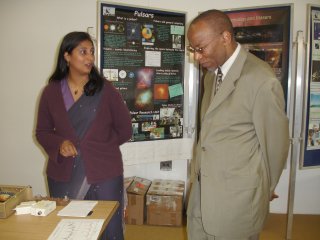
Click on image for LARGE version. Credit: Marion West / HartRAO
Moving from star death to star birth, Dr. Sharmila Goedhart told the
Minister about research into star formation using masers as tracers of the
environment in which it occurs. Here Sharmila describes the startling
discovery that several of the methanol masers show periodic veriations -
they tick like clocks, albeit with periods of months.
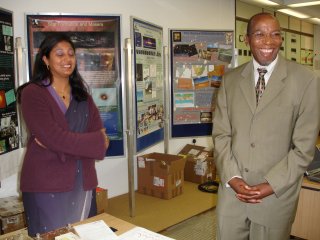
Click on image for LARGE version. Credit: Marion West / HartRAO
The Minister enjoyed questioning Sharmila about the masers.
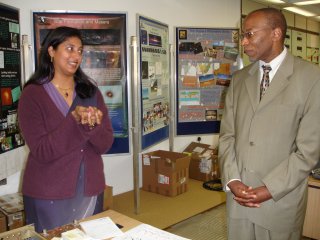
Click on image for LARGE version. Credit: Marion West / HartRAO
Sharmila illustrates how the collapse of dense molcular clouds triggers star
formation.
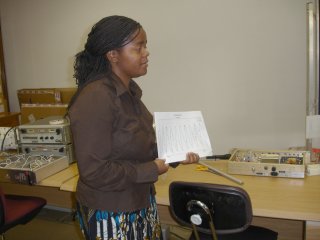
Click on image for LARGE version. Credit: Marion West / HartRAO
NASSP MSc student Christina Langa described her startling results obtained
from daily monitoring of a methanol maser that had shown up in Sharmila's
earlier fortnightly maser monitoring as "flickering" rapidly. Christina is
registered at North-West University for her MSc.
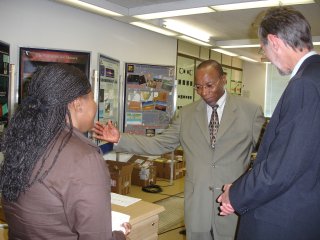
Click on image for LARGE version. Credit: Marion West / HartRAO
The Minister checks his understanding of what Christina has told him.
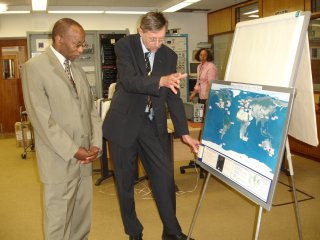
Click on image for LARGE version. Credit: Marion West / HartRAO
Mike demonstrates the geographical importance of the radio telescope at
HartRAO in global networks of radio telescopes used both for astronomy and
for geodetic research. The data from these telescopes are combined using
the technique known as Very Long Baseline Interferometry (VLBI).
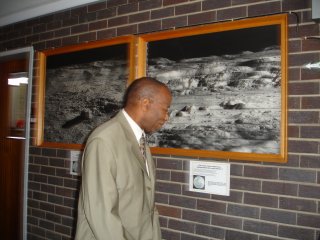
Click on image for LARGE version. Credit: Marion West / HartRAO
The Minister takes a close look at the images of the surface of the Moon
taken by the Lunar Orbiter spacecraft in the runup to the Apollo Moon
landings. At that time the station was part of the NASA Deep Space Network,
receiving data from such spacecraft.
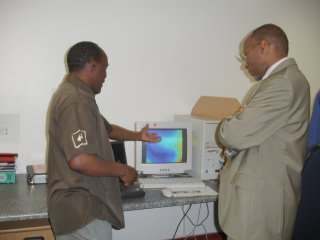
Click on image for LARGE version. Credit: Marion West / HartRAO
In the Space Geodesy Laboratory, PhD student Joel Ondego Botai describes his
investigation into the effects of water vapour on the accuracy of radio
telescope positions determined from intercontinental VLBI campaigns. Joel
is registered for his degree at Pretoria University.
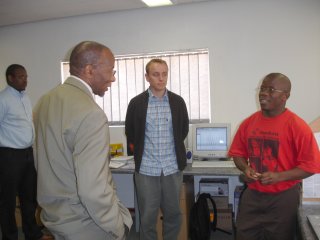
Click on image for LARGE version. Credit: Marion West / HartRAO
MSc student Sakia Madiseng discusses his investigation into potential new
sites suitable for space geodetic instrumentation. Sakia is doing his MSc
through the University of the Witwatersrand.
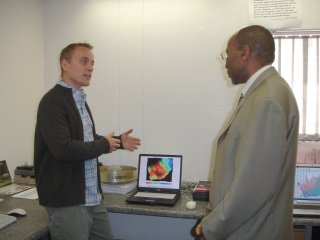
Click on image for LARGE version. Credit: Marion West / HartRAO
Attie Combrink has been using data from GPS base stations across southern
Africa to measure the precipitable water vapour content of the atmosphere,
and how it is changing over time, for his PhD. Attie recently submitted
his thesis for examination at the University of Cape Town.
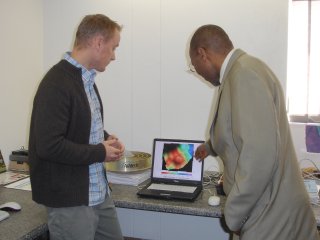
Click on image for LARGE version. Credit: Marion West / HartRAO
The Minister asks about the implications of the changing water vapour
pattern over southern Africa.
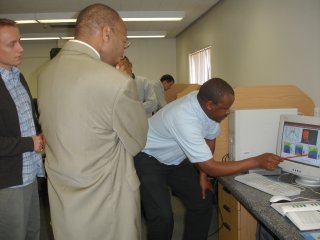
Click on image for LARGE version. Credit: Marion West / HartRAO
For his PhD research Mojalefa Moeketsi is using GPS data to measure the
total electron content of the ionosphere - the ionised upper part of the
atmosphere - the correlation with the changing radiation from the Sun during
the eleven year solar cycle. Mojalefa is registered for his degree with
Rhodes University.
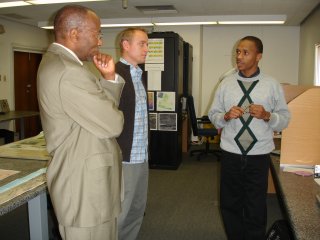
Click on image for LARGE version. Credit: Marion West / HartRAO
Sandile Ngcobo is developing a high-powered pulsed laser for his MSc
research project. The aim is for this to be used in a new laser ranger to
replace the ageing NASA MOBLAS-6 SLR. Sandile is currently based at the
National Laser Centre at the CSIR, and is registered with the University of
Stellenbosch for his degree.
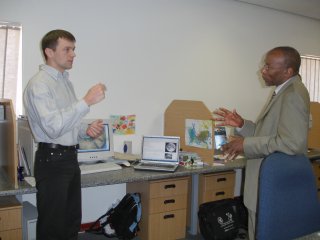
Click on image for LARGE version. Credit: Marion West / HartRAO
Dr. Vasyl Suberlak described his work developing the proposed new laser
ranger, which is intended to be capable of lunar laser ranging as well as
ranging satellites in Earth orbit. Vasyl did his PhD in laser ranging in
the Ukraine.
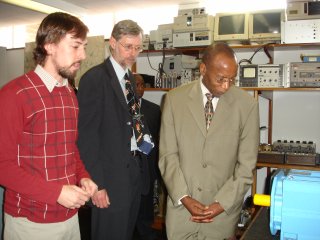
Click on image for LARGE version. Credit: Marion West / HartRAO
Moving on to the electronic workshop, Paul Prozesky demonstrated the "hot
spare" electric motor for the 26-m radio telescope. The replacement of the
original hydraulic motors by pairs of electric motors on each axis in 1998
provided much improved pointing precision and control.
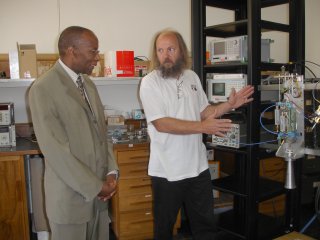
Click on image for LARGE version. Credit: Marion West / HartRAO
Engineer Keith Jones describes the new 22-GHz / 1.3-cm wavelength receiver
under test in the microwave laboratory. This is designed to capitalise on
the much extended wavelength range over which the 26-m telescope can operate
since the installation of the high-precision, solid main surface panels
between 2000 and 2004.
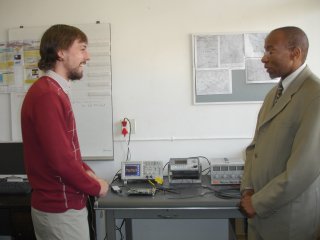
Click on image for LARGE version. Credit: Marion West / HartRAO
Paul Prozesky in the new digital electronics laboratory describes how we
will be replacing analogue electronics with digital systems using FPGA's.
This technology is being implemented in collaboration with the team
developing the Karoo Array Telescope (KAT).

Click on image for LARGE version. Credit: Marion West / HartRAO
Richard Moralo demonstrates the skills he is gaining in the mechanical
workshop. Here is using the milling machine to cut an adaptor plate to
permit the mounting of a chuck on the machine.
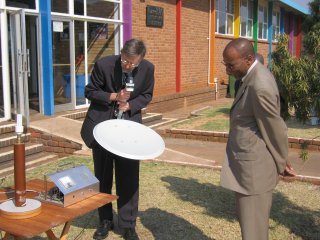
Click on image for LARGE version. Credit: Linda Pretorius /
Southern Science
Outside the Visitors Centre, Mike showed how a standard satellite dish can
also function as a small radio telescope, and easily detects the radio
emission from the Sun.
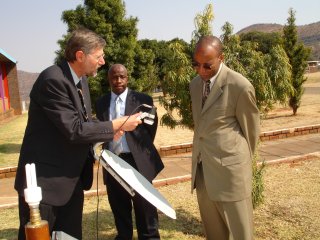
Click on image for LARGE version. Credit: Marion West / HartRAO
More surprisingly perhaps, a satellite dish also detects microwave emission
from the human body!
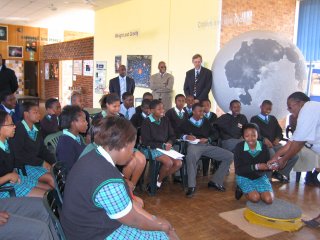
Click on image for LARGE version. Credit: Linda Pretorius /
Southern Science
The Minister saw the Science Awareness team in action, with two busloads of
learners from Ikaneng Combined School visiting the observatory. Here
Anacletta Koloko is helping learners discover the mysteries of angular
momentum on a turntable.
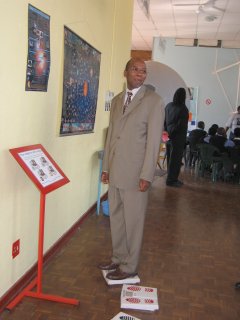
Click on image for LARGE version. Credit: Linda Pretorius /
Southern Science
How much would one weigh on the planet Jupiter? The Minister finds out!
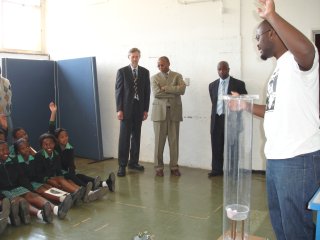
Click on image for LARGE version. Credit: Marion West / HartRAO
Sam Rametse shows learners what happens to marshmallows when they are put in
a vacuum chamber, using equipment developed by MEng student Benjamin Klein.
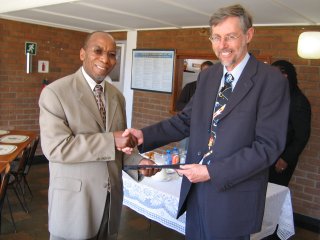
Click on image for LARGE version. Credit: Linda Pretorius /
Southern Science
The visit ended with the handover of a brochure of background information on
the Observatory.
